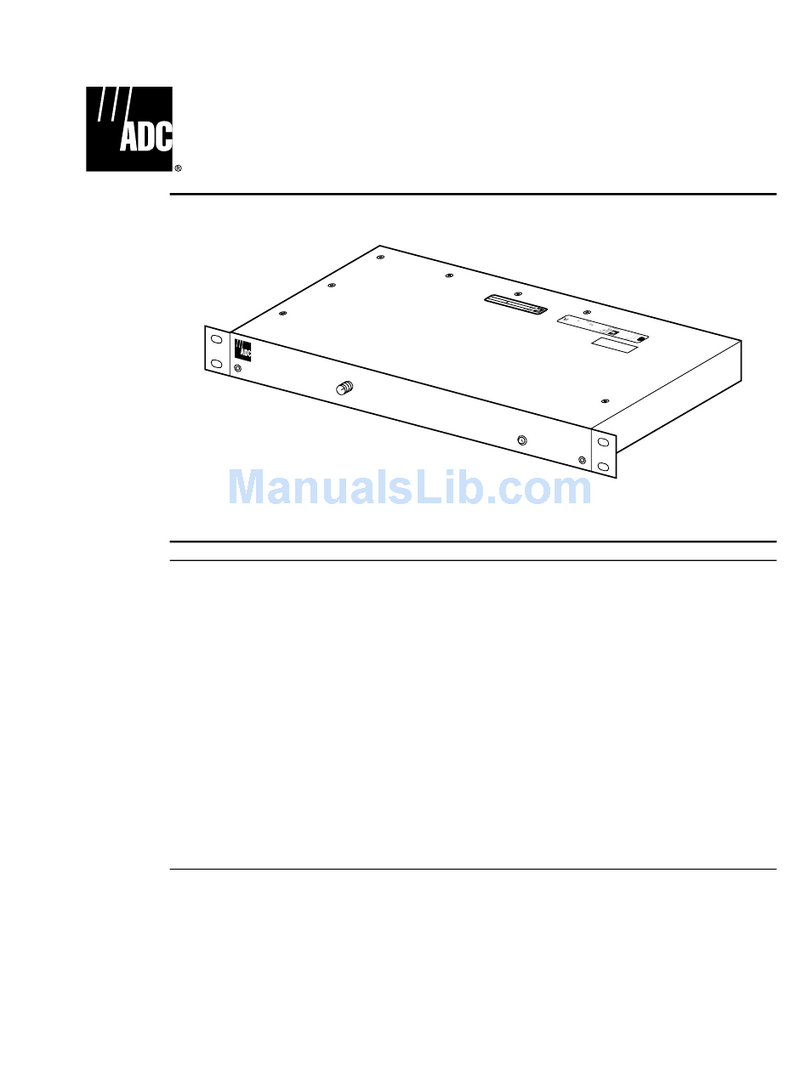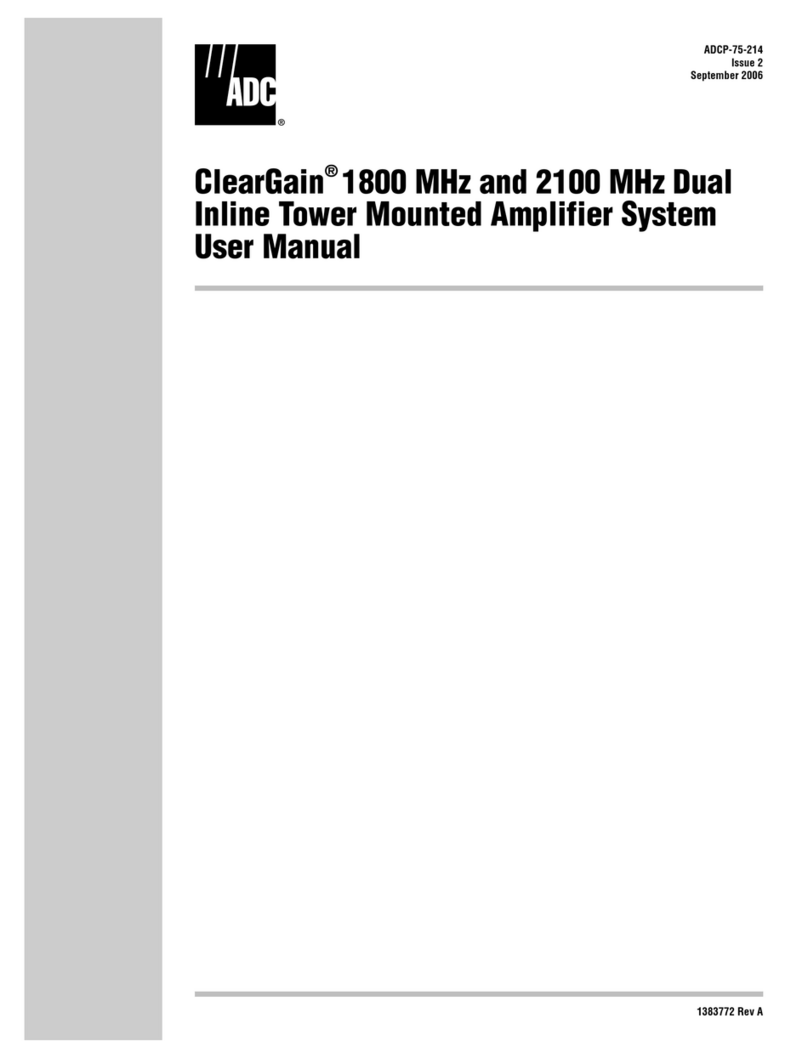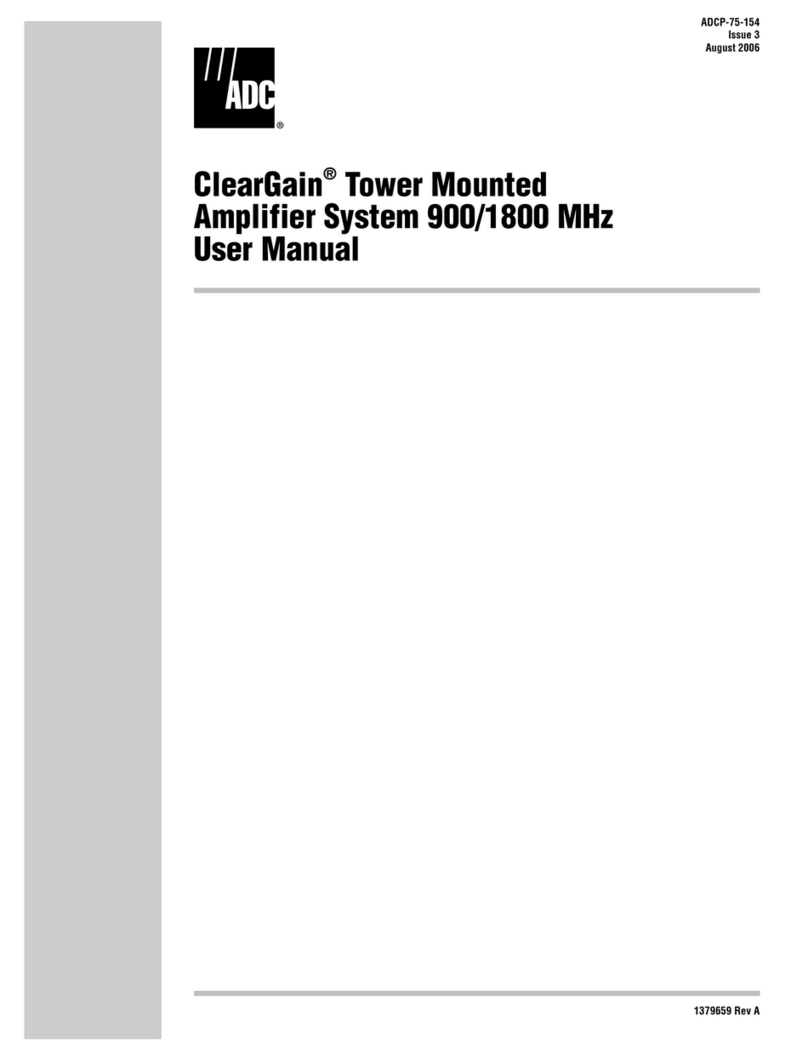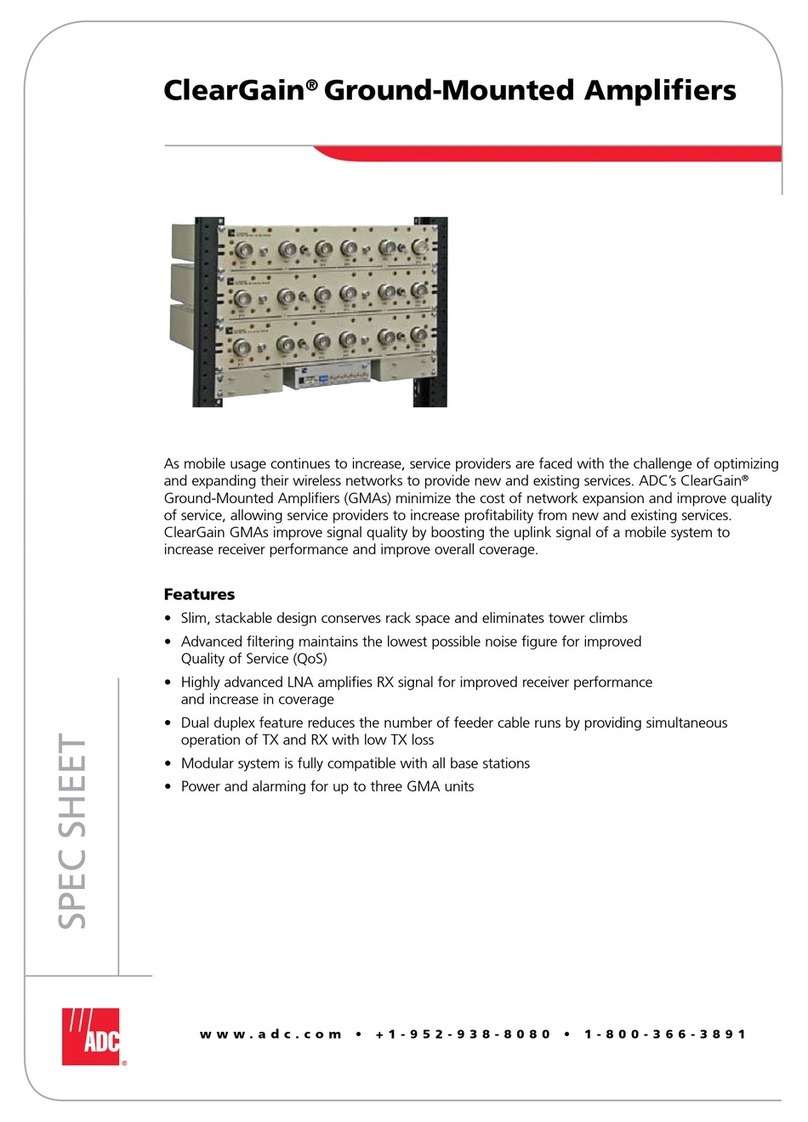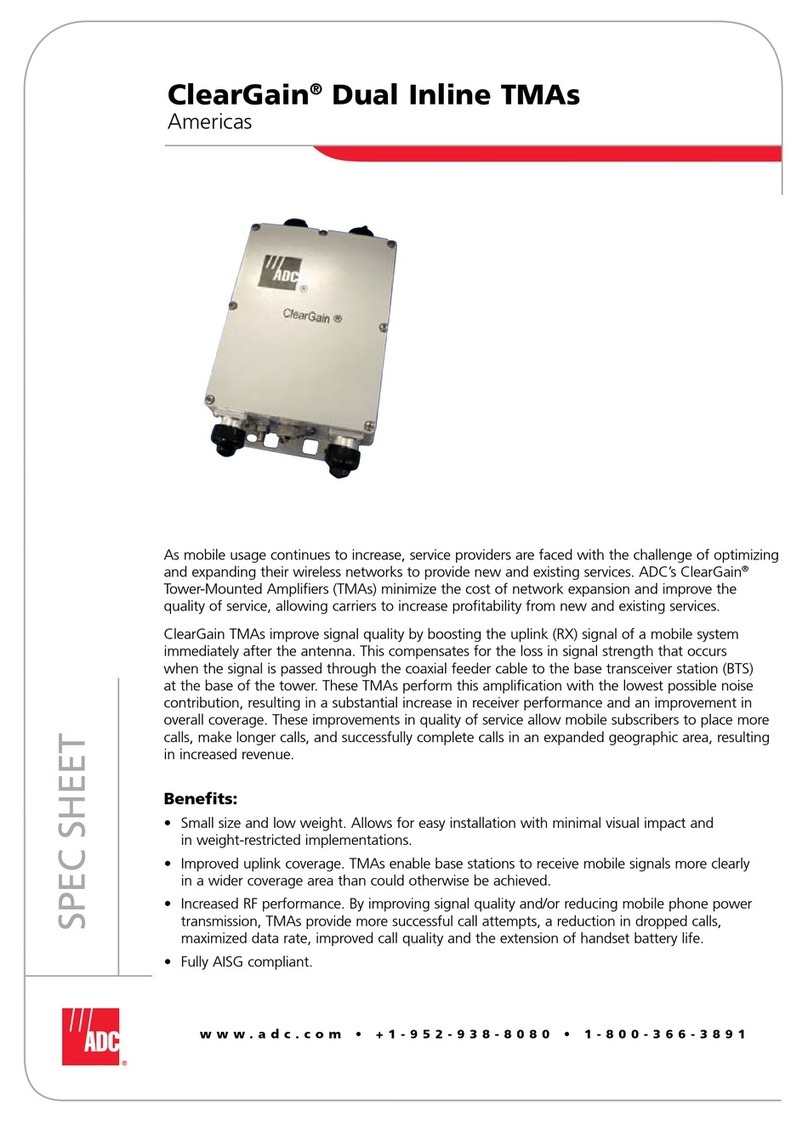
LOOPBACK TESTING
Initiate loopback testing from the maintenance menus or use the MODE and SEL
pushbuttons. Testing can also be initiated by usinga test set to send inband codes (Table 1).
Refer to the user manual, document number LTPH-UM-1122-xx, for more information.
Front Panel
List number
CLEI/ECI bar code label
Craft port provisioning
To access all system maintenance, provisioning and
screens, connect a standard 9-pin terminal cable between the
serial port on a PC and the H4TU-C-388 craft port.
performance
Four-character display
Displays status, provisioning, and alarm messages.
See tables belowfor a list of message descriptions.
DSX-1 bridging jacks
Status LED
A Customer Remote (CREM)
loopback or a Network Local
(NLOC) loopback is in effect.
Green LED Normal operation.
HDSL4 acquisition or
system alarm.
Red LED Fuse alarm.
Flashing Red LED
Yellow LED
FlashingYellow LED System is in Armed (ARM)
mode.
Off Line power is off.
(on PC board)
Configuration number
H
4
T
U
•
3
8
8
C
M
O
D
E
S
E
L
D
S
1
BRG
I
N
O
U
T
RS-232
DCE
L1
MaintenanceTerminal Modem Settings
9600 baud
8 data bits
No parity
1 stop bit
Hardware flow control:OFF
Terminal emulation software:VT100
Card handle
Lift to release.
Lower to secure H4TU-C.
Card-edge Connector
* Fuse alarm is normally floating (0 to 80V max.) and
at -48V (10 mA max.) when activated.
106
105
104
103
102
101
100
DSX-1OUT
DSX-1IN
205
204
203
202
201
200
119
118
117
116
115
114
113
112
111
110
GND GND
FrameGND
Fusealarm*
Ring1
Tip1
Factoryuseonly
Ring
Tip
Factoryburn-in
-48Vdc
219
218
217
216
215
214
213
212
211
210
209
208
207
206
109
108
107
HDSL4Loop1
RingA
TipA
HDSL4Loop2
RingB
TipB
STAT
MODE and SEL pushbuttons (for manual
setting of system parameters)
Use MODE and SEL to manually modify user options,
oopbacks, and display DSX-1 line parameters. initiate
l
1
2
3
4
Press the MODE pushbutton for 1 second and release.
The front panel alternately displays the first system
parameter and its current setting.
Press SEL to step through all possible settings for
the displayed parameter.
Press MODE to update the parameter and advance
to the next parameter.
After scrolling through all the parameters, press SEL
to confirm changes when prompted with a CONF NO
message, or press MODE to cancel all changes. Provides non-intrusive bridging jack access to (IN) and from
(OUT) the HDSL4 span at the DSX-1 interface. Allows monitoring
of the DS1 payloads.
To initiate a manual loopback:
1
Press both the MODE and SEL pushbuttons for at least
3 seconds.The following message appears:
Press SEL to activate the NLOC loopback or press
MODE to select the next available loopback.
, press both the
MODE and SEL pushbuttons for 3 or more seconds
MAN LPBK NLO?
2
To manually terminate a loopback
(inside handle)
Table 1. GNLB Loopback Commands
Loopback Inband Code Description
NLOC 1111000 DSX-1 signal is looped back to the network at the H4TU-C.
NREM 1110000 DSX-1 signal is looped back to the network at the H4TU-R.
CLOC 1111100 DS1 signal from customer is looped back to the customer at the H4TU-R.
CREM 1111110 DS1 signal from customer is looped back to the customer at the H4TU-C.
NDU1 110000 Signal is looped back to the network at H4D1.
NDU2 111000 Signal is looped back to the network at H4D2.
CDU1 111100 Signal from customer is looped back to the customer at H4D1.
CDU2 111110 Signal from customer is looped back to the customer at H4D2.
SMJK 11000 DSX-1 signal is looped back to the network at the H4TU-R SmartJack module.
Loopdown 11100 Deactivates any of the above loopbacks.
Table 2. Front-Panel Alarm Messages(a)
(a) Front panel alarm messages are listed in order of priority. ALRM displays prior to any alarm message.
Pressing the LBK button initiates an Alarm Cutoff (ACO) message.
Message Description
PWR FEED SHRT (b)
(b) Message displays repeatedly as long as the alarm condition exists and is not included in the priority order.
A short between Loop 1 and Loop 2 of the HDSL4 pairs.
PWR FEED GND (b) The HDSL4 loop is grounded.
PWR FEED OPEN (b) A line-power open condition.
SPNn-LOSW The HDSL4 loop has lost synchronization. The span closest to the network has
highest priority. (n= span number)
LLOS No signal is detected at the DSX-1 input to the H4TU-C.
RLOS No signal is detected at the DS1 input to the H4TU-R.
LAIS Line Alarm Indication Signal.
RAIS Remote Alarm Indication Signal.
LRAI An RAI alarm (yellow) from the Customer Premises Equipment (CPE) with an
error-free signal from the line unit or network. RAI signal is transmitted towards the
network.
RRAI An RAI alarm (yellow) from the CPE with errors from the line unit or network.
xxx-LOF DS1 input does not contain the ESF or SF frame pattern setting of the FRMG option.
(xxx denotes either Transmission Unit Central Office [TUC] or Transmission Unit
Remote End [TUR]).
xxx-DBER A system DS1 Bit Error Rate (DBER) alarm (xxx denotes either TUC or TUR).
PRMF H4TU-R Performance Report Messaging BER threshold exceeded at far end.
PRMN H4TU-R Performance Report Messaging BER threshold exceeded at near end.
xxxx-HBRx(c)
(c) The xxxx prefix denotes TUC, TUR, or a first or second doubler interface, upstream or downstream (DUxU
or DUxD, where x= Doubler 1 or 2). The single xsuffix denotes Loop 1 or Loop 2.
A system HDSL4 Block Error Rate (HBER) alarm.
xxxx-MALx(c) The margin on the HDSL4 loop has dropped below the threshold setting.
xxxx-LAx(c) The attenuation on the HDSL4 loop has exceeded the maximum threshold value.
To comply with the intrabuilding wiring requirements of GR-1089
CORE, Section 4.5.9, the shields of the ABAM-type cables that
connect the H4TU-C-388 List 1 DSX-1 output ports to the
cross-connect panel must be grounded at both ends.
Network Customer
Premises
NLOC NDU1 NDU2 CLOC
CDU1 CDU2CREM NREM
TLOS*
H4TU-C H4D1 H4D2 H4TU-R
SMJK
DS1
DSX-1
*
When enabled,TLOS is an automatic loopback
that occurs with an LOS at the remote DS1 input.
Span 1 Span 2 Span 3
Downstream Upstream
Table 3. Front Panel Diagnostic Messages
Message (a)
(a) Normal operating messages are in bold.
Description
A=xx The Attenuation (A) message appears followed by xx, where xx is the highest loop
attenuation of all HDSL interfaces.
ACQ1 or ACQ2 The multiplexers of the H4TU-C and H4TU-R are trying to establish synchronization over
HDSL4 Loop 1 or Loop 2.
ARM Armed to respond to Intelligent Repeater Loop (ILR) codes.
BAD RT? The H4TU-C has not received a response from the H4TU-R.
FERR A framing bit error has occurred at H4TU-C DSX-1 input.
HxES H4TU-C HDSL4 Loop 1 or Loop 2 Cyclical Redundancy Check (CRC) error. (Loop 1 has
display priority over Loop 2.)
LBPV A local bipolar violation has been received at the DSX-1 input to the H4TU-C.
1=xx or
2=xx
Power of the received HDSL4 signal on each loop relative to noise (S/N with respect to
21.5 dB). (xx denotes lowest margin in dB for Loop 1 and Loop 2.)
PWR FEED OFF HDSL4 span power is off.
PWR FEED ON HDSL4 loop is not grounded or shorted.
SIG1 or SIG2 H4TU-C and H4TU-R transceivers are trying to establish contact with each other over
HDSL4 Loop 1 or Loop 2.
Table 4. Front-Panel Configuration Options Using MODE and SEL(a)
(a) Front-panel configuration options display in the order listed.
Message (b)
(b) Normal operating messages are in bold.
Description
EQL Sets the DSX-1 equalizer to: 0 (0 to 133 ft.), 133 (133 to 266 ft.), 266 (266 to 399 ft.),
399 (399 to 533 ft.), 533 (533 to 655 ft.).
RLBO Sets the H4TU-R line buildout to 0 dB, -7.5 dB, or -15 dB.
LPBK Enables (ENA) or disables (DIS) SmartJack loopback commands.
PWRF OFF = disables line power; AUTO = -185 Vdc or ±123 Vdc (depending on number of
downstream units detected); LOW = -185 Vdc; and HIGH = ±123 Vdc.
HBER 1E-6 or 1E-7 = alarm activates when the HDSL4 BER alarm threshold exceeds 10-6 or 10-7.
NONE = prevents generation of a system alarm due to BER.
DBER Enables (ENA) or disables (DIS) fixed 24-hour DSX-1 BER alarm threshold.
LBTO Loopback timeout = NONE, 20 min, 60 min, 120 min, 8 hr, and 24 hr.
DS1 DSX-1 line code = AUTO, B8ZS, or AMI.
FRMG DS1 frame formatting mode = AUTO (automatic framing), SF (SuperFrame), ESF (Extended
SuperFrame), or UNFR (unframed).
RDA Enables (ENA) or disables (DIS) alarm indications due to remote DS1 LOS at the H4TU-R
input.
ALMP Enables system to output an alarm pattern: AIS or LOS.
BPVT Enables (ENA) or disables (DIS) Bipolar Violation Transparency.
NLBP Enables the H4TU-R to transmit either AIS or LOS towards the CI for any network loopback.
TLOS Enables (ENA) or disables (DIS) a logic loopback at the H4TU-R when an LOS occurs at its
DS1 input.
RTPV Enables (ENA) or disables (DIS) remote provisioning.
PBON Configures the power output levels of the H4TU-C network unit toward the customer to
comply with Default (DEF) or Enhanced (ENH) templates.
PBOC Configures the power output levels of the H4TU-R customer unit toward the network to
comply with Default (DEF) or Enhanced (ENH) templates.
Table 5. Front-Panel System Information Messages (Scroll Mode) (a)
(a) To scroll through system information messages, press the MODE button for 3 or more seconds.
Message Description Message Description
VER x.xx Firmware version. CODE xxxx Line code setting (AUTO, AMI,
B8ZS). Default is AUTO.
LIST xx Product list number. LATT xx Loop attenuation threshold
(0 to 50 dB). Default is 38.
FRM xxxx Frame pattern received from the
DSX-1 (SF, ESF, or UNFR).
MARG xx Margin threshold (0 to 15 dB).
Default is 4.
Copies of this publication or the user manual
(LTPH-UM-1122-xx) can be downloaded at www.adc.com. To
order a hard copy, contact your sales representative.
